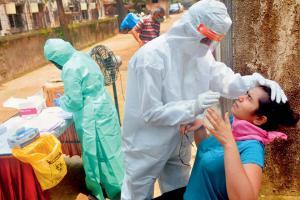With high expectations from the Modi-led Centre, the Maharashtra government faces the dual challenge of saving lives and its economy

BMC doctors test residents of a building in Ghatkopar west for COVID-19. TIFR's findings suggest ways to prevent disease progression. Pic/Sayyed Sameer Abedi
 As the state government seeks legislative approval for several measures, including additional expenditure and some bills on Monday and Tuesday, the mandarins will have a new surge of COVID-19 cases and a bad economy in Maharashtra on their minds. Under pressure not only from other parties but also from some leaders within the three-party formation, the government is expected to rethink easing the restrictions, because some of the state's expert partners have cautioned it against rushing into things that will cause a further spike in the cases.
As the state government seeks legislative approval for several measures, including additional expenditure and some bills on Monday and Tuesday, the mandarins will have a new surge of COVID-19 cases and a bad economy in Maharashtra on their minds. Under pressure not only from other parties but also from some leaders within the three-party formation, the government is expected to rethink easing the restrictions, because some of the state's expert partners have cautioned it against rushing into things that will cause a further spike in the cases.
We don't know yet what the legislature will discuss over the two days as far as the pandemic is concerned. And if they debate it at all, it shouldn't be a repeat of what the government and the opposition have been saying. Rather than help us mitigate the crisis, the political debates may just shift the focus from the real issue at hand that, if addressed together and thoughtfully, can save us from the worst of the calamity. It is actually a dual challenge of saving the lives and ensuring the economic survival of Maharashtra, which has been providing the country's growth engine with the most powerful cylinders to fire fiercely on, as and when required. Maharashtra needs a hard paddle-push from the Narendra Modi government which regulates the engine.
ADVERTISEMENT
State can't fight struggling economy alone
The situation is such that the states, including Maharashtra, cannot fight the struggling economy in isolation and need the Centre's assistance, more so because of the reformed tax structure which guarantees states a handsome share of the revenue collected throughout the country. The non-BJP states have specifically asked for the Goods and Services Tax (GST) compensation which runs into many thousand crores for each claimant. The BJP states may not resent it openly but they are also feeling the heat and may soon beg for the 'Act of Centre'.
One of the toppers in COVID-19 cases, Maharashtra is unlikely to resume full-ledged activities that keep the wheels of the economy rolling. The growth in cases is happening in the major industrial belts of the state. The Pune-Mumbai-Nashik golden triangle is hit badly, and so it is Aurangabad that completes a manufacturing quadrangle. Enterprising districts of Ahmednagar, Kolhapur, Solapur, Satara and the state's second capital Nagpur where the economy has improved in the past decade, have been affected by the exponential growth in COVID-19 cases. Now it emerges that the Centre will not provide the state with ventilators, masks and PPE kits. Maharashtra needs the equipment more than ever.
The health and economic concerns have aggravated because the urban-centric infection has reached the rural areas where agriculture activities have to be carried out uninterrupted. The fear has been knocking on the peasants' doors for long and now the virus has entered their protected space.
TIFR raises alarm
As we are into staggered unlocking, the Tata Institute of Fundamental Research (TIFR) has raised an alarm by recommending that further easing of restrictions be delayed till November 1.
TIFR's new computer modelling prediction says that if the current restrictions on economic activity and movement are all removed immediately, cases in Maharashtra could rise to more than 70 lakh by December, thus creating a second wave-like situation. It adds that full attendance in the offices should not be allowed for the time being and schools and colleges should be kept closed till January next year. TIFR has been collaborating with the Brihanmumbai Municipal Corporation (BMC). It predicts herd immunity by December or January next year when around 75 per cent are infected in slums and 50 per cent in non-slum areas. The findings suggest ways to prevent disease progression in order to not strain the state's health infrastructure. The simulation model has taken into account reopening of local trains, offices and schools, and found protocol followed in containment zones as a better intervention.
Simply put, we now stand at the crossroads, where choices are hard to make but must be made. The Centre and state governments have made some choices inviting reactions of varied nature, and they will make some more in the days to come. The people can only hope for the better.
Dharmendra Jore is political editor, mid-day. He tweets @dharmendrajore
Send your feedback to mailbag@mid-day.com
Keep scrolling to read more news
Catch up on all the latest Mumbai news, crime news, current affairs, and a complete guide from food to things to do and events across Mumbai. Also download the new mid-day Android and iOS apps to get latest updates.
Mid-Day is now on Telegram. Click here to join our channel (@middayinfomedialtd) and stay updated with the latest news
 Subscribe today by clicking the link and stay updated with the latest news!" Click here!
Subscribe today by clicking the link and stay updated with the latest news!" Click here!







